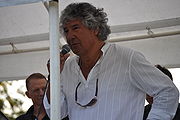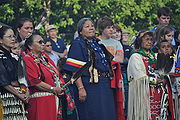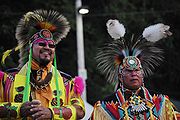
United Indians of All Tribes
Encyclopedia
United Indians of All Tribes (also known as the United Indians of All Tribes Foundation, or UIATF) is a non-profit foundation that provides social and educational services to Native Americans
in the Seattle metropolitan area
and aims to promote the well being of the Native American community of the area. The organization is based at the Daybreak Star Cultural Center
in Seattle, Washington's Discovery Park.
area, because of the rich resources of food and fish. Major groups of local contemporary native peoples or tribes include the Suquamish
, Duwamish
, Nisqually
, Snoqualmie
, and Muckleshoot
(Ilalkoamish, Stuckamish, and Skopamish) tribes. Many Alaskan Natives and Native Americans from the Inland Northwest
have also come to live in Seattle. As a result, the city has a large and very diverse urban Indian
population. According to the 2000 U.S. Census, there are 86,649 American Indians/Alaskan Natives living in the Seattle, Tacoma
, and Bremerton
area. The Seattle area has become a nexus of many different tribal cultures from all over the country, with large influences from Coast Salish
, Tlingit, Haida, and Plateau Indian cultures.
 UIATF was established in 1970 during the struggle by Northwest Natives to gain ownership or control of a portion of Fort Lawton
UIATF was established in 1970 during the struggle by Northwest Natives to gain ownership or control of a portion of Fort Lawton
, as the United States Army
had shrunk its base there. Bernie Whitebear
emerged as the group's CEO, a position he held until shortly before his death from cancer in 2000. After winning the concession of a renewable 99-year lease on 20 acres (81,000 square meters) in what was to become Discovery Park
, Whitebear led the fund-raising for Daybreak Star. Whitebear's brother, the designer and sculptor Lawney Reyes
, set forth the "philosophy, nomenclature, and organizational needs of UIATF," working with Northwest architect Arai Jackson to design the center. Whitebear negotiated with then-governor Daniel J. Evans
for a $1 million construction grant from Washington State; he also obtained an $80,000 grant for artwork for the building's interior from the Seattle Arts Commission, of which he became a member. Further donations came from tribes and corporations, including many of the materials used in the building.
Beginning in 1975 with the grant for artwork, the foundation opened the Sacred Circle Art Gallery at Daybreak Star. The Sacred Circle Art Gallery features both a permanent collection as well as a temporary exhibit space. Until 2001, the gallery featured contemporary art by renowned Native artists such as James Lavadour
, Edgar Heap of Birds
, and Marvin Oliver. After Whitebear's death, a new group of leaders made changes to the gallery, such as changing its name from the Sacred Circle Art Gallery to the Daybreak Star Indian Art Gallery, whittling two viewing rooms down to one, and shifting the focus away from contemporary Native American art. The gallery carries some contemporary work and continues to rebrand itself. Daybreak has also put on several art markets throughout the year.
 The Daybreak Star Foundation also provides programs such as Indian child welfare services, therapy, and treatment; elder services, including a lunch program; a GED education program; and youth services, including advocacy, substance abuse treatment
The Daybreak Star Foundation also provides programs such as Indian child welfare services, therapy, and treatment; elder services, including a lunch program; a GED education program; and youth services, including advocacy, substance abuse treatment
, and housing for homeless youth. Other programs have included the Ina Maka family program, education and employment services, a child development center, and the ECEAP (Early Childhood Education & Assistance Program) preschool. The foundation also organizes the annual Seafair
Indian Days, one of the larger pow-wow
s in the Northwest, held in conjunction with the city's festival called Seafair. The pow-wow draws tribal members from across the state, Oregon, Idaho, Montana, and Canada.
 Another initiative contemplated by Whitebear was the People's Lodge at Daybreak Star, intended to include a Hall of Ancestors, a Potlatch House, a theater, and a museum, later called the "Daybreak Star Village" proposal, a project now indefinitely postponed for financial reasons. There is also the Pacific Northwest Indian Canoe Center, intended as part of the ongoing development at South Lake Union
Another initiative contemplated by Whitebear was the People's Lodge at Daybreak Star, intended to include a Hall of Ancestors, a Potlatch House, a theater, and a museum, later called the "Daybreak Star Village" proposal, a project now indefinitely postponed for financial reasons. There is also the Pacific Northwest Indian Canoe Center, intended as part of the ongoing development at South Lake Union
, just north of downtown,—for which ground was broken February 28, 2007. Both the People's Lodge and the Canoe Center were conceived by Whitebear but left in the planning phases at the time of his death.
Current UIATF initiatives include:
Proposed UIATF initiatives include:
A $3.5 million grant received October 2007 from the Northwest Area Foundation should allow the Bernie Whitebear Center, Daybreak Star College—two of the proposed projects—and the Northwest Canoe Center to proceed. The Canoe Center will be on South Lake Union
. The grant will also fund various economic development activities focused on employment and small business development.
Native Americans in the United States
Native Americans in the United States are the indigenous peoples in North America within the boundaries of the present-day continental United States, parts of Alaska, and the island state of Hawaii. They are composed of numerous, distinct tribes, states, and ethnic groups, many of which survive as...
in the Seattle metropolitan area
Seattle metropolitan area
The Seattle metropolitan area in the US state of Washington includes the city of Seattle, King County, Snohomish County, and Pierce County within the Puget Sound region. The U.S...
and aims to promote the well being of the Native American community of the area. The organization is based at the Daybreak Star Cultural Center
Daybreak Star Cultural Center
The Daybreak Star Cultural Center is a Native American cultural center in Seattle, Washington, described by its parent organization United Indians of All Tribes as "an urban base for Native Americans in the Seattle area." Located on 20 acres in Seattle's Discovery Park in the Magnolia...
in Seattle, Washington's Discovery Park.
History of Native Americans in the Seattle area
Many tribes historically inhabited the Seattle area and, to a greater extent, the surrounding Puget SoundPuget Sound
Puget Sound is a sound in the U.S. state of Washington. It is a complex estuarine system of interconnected marine waterways and basins, with one major and one minor connection to the Strait of Juan de Fuca and the Pacific Ocean — Admiralty Inlet being the major connection and...
area, because of the rich resources of food and fish. Major groups of local contemporary native peoples or tribes include the Suquamish
Suquamish
The Suquamish are a Lushootseed-speaking Native American Tribe, located in present-day Washington in the United States.The Suquamish are a southern Coast Salish people; they spoke a dialect of Lushootseed, which belongs to the Salishan language family. Like many Northwest Coast natives, the...
, Duwamish
Duwamish (tribe)
The Duwamish are a Lushootseed Native American tribe in western Washington, and the indigenous people of metropolitan Seattle, where they have been living since the end of the last glacial period...
, Nisqually
Nisqually (tribe)
Nisqually is a Lushootseed Native American tribe in western Washington state in the United States. The tribe lives on a reservation in the Nisqually River valley near the river delta. The Nisqually Indian Reservation, at , comprises 20.602 km² of land area on both sides of the river, in...
, Snoqualmie
Snoqualmie (tribe)
The Snoqualmie Tribe is a tribal government of Coast Salish Native American peoples from the Snoqualmie Valley in east King and Snohomish Counties in Washington state. The Snoqualmie settled onto the Tulalip Reservation after signing the Point Elliott Treaty with the Washington Territory in 1855...
, and Muckleshoot
Muckleshoot
The Muckleshoot are a Lushootseed Native American tribe, part of the Coast Salish peoples of the Pacific Northwest whose traditional territory and reservations is located in the area of Auburn, Washington, between Seattle and Tacoma...
(Ilalkoamish, Stuckamish, and Skopamish) tribes. Many Alaskan Natives and Native Americans from the Inland Northwest
Inland Empire (Pacific Northwest)
thumb|The Inland Empire regionThe Inland Northwest, or Inland Empire, is a region in the Pacific Northwest centered on Spokane, Washington, including the surrounding Columbia River basin and all of North Idaho....
have also come to live in Seattle. As a result, the city has a large and very diverse urban Indian
Urban Indian
Urban Indians are Native Americans in the United States who live in urban areas. Urban Indians represent a growing proportion of the Native population in the United States...
population. According to the 2000 U.S. Census, there are 86,649 American Indians/Alaskan Natives living in the Seattle, Tacoma
Tacoma, Washington
Tacoma is a mid-sized urban port city and the county seat of Pierce County, Washington, United States. The city is on Washington's Puget Sound, southwest of Seattle, northeast of the state capital, Olympia, and northwest of Mount Rainier National Park. The population was 198,397, according to...
, and Bremerton
Bremerton, Washington
Bremerton is a city in Kitsap County, Washington, United States. The population was 38,790 at the 2011 State Estimate, making it the largest city on the Olympic Peninsula. Bremerton is home to Puget Sound Naval Shipyard and the Bremerton Annex of Naval Base Kitsap...
area. The Seattle area has become a nexus of many different tribal cultures from all over the country, with large influences from Coast Salish
Coast Salish
Coast Salish languages are a subgroup of the Salishan language family. These languages are spoken by First Nations or Native American peoples inhabiting the territory that is now the southwest coast of British Columbia around the Strait of Georgia and Washington state around Puget Sound...
, Tlingit, Haida, and Plateau Indian cultures.
History of Daybreak Star

Fort Lawton
Fort Lawton is a United States Army fort located in the Magnolia neighborhood of Seattle, Washington. The fort was included in the 2005 Base Realignment and Closure list.-History:...
, as the United States Army
United States Army
The United States Army is the main branch of the United States Armed Forces responsible for land-based military operations. It is the largest and oldest established branch of the U.S. military, and is one of seven U.S. uniformed services...
had shrunk its base there. Bernie Whitebear
Bernie Whitebear
Bernie Whitebear , birth name Bernard Reyes, was an American Indian activist, a co-founder of the Seattle Indian Health Board , the United Indians of All Tribes Foundation, and the Daybreak Star Cultural Center....
emerged as the group's CEO, a position he held until shortly before his death from cancer in 2000. After winning the concession of a renewable 99-year lease on 20 acres (81,000 square meters) in what was to become Discovery Park
Discovery Park (Seattle)
Discovery Park is a 534 acre park in the peninsular Magnolia neighborhood of Seattle, Washington. It is the city's largest public park and contains 11.81 miles of walking trails. United Indians of All Tribes' Daybreak Star Cultural Center is within the park's boundaries...
, Whitebear led the fund-raising for Daybreak Star. Whitebear's brother, the designer and sculptor Lawney Reyes
Lawney Reyes
Lawney L. Reyes is an American Indian artist, curator and memoirist.-Life:Reyes' mother, born Mary Christian, was Sin Aikst ; his father, Julian Reyes, was Filipino, but had largely assimilated to an Indian way...
, set forth the "philosophy, nomenclature, and organizational needs of UIATF," working with Northwest architect Arai Jackson to design the center. Whitebear negotiated with then-governor Daniel J. Evans
Daniel J. Evans
Daniel Jackson Evans served three terms as the 16th Governor of the state of Washington from 1965 to 1977, and represented the state in the United States Senate from 1983 to 1989....
for a $1 million construction grant from Washington State; he also obtained an $80,000 grant for artwork for the building's interior from the Seattle Arts Commission, of which he became a member. Further donations came from tribes and corporations, including many of the materials used in the building.
Beginning in 1975 with the grant for artwork, the foundation opened the Sacred Circle Art Gallery at Daybreak Star. The Sacred Circle Art Gallery features both a permanent collection as well as a temporary exhibit space. Until 2001, the gallery featured contemporary art by renowned Native artists such as James Lavadour
James Lavadour
James Lavadour is a Walla Walla painter and printmaker. Co-Founder of the Crow's Shadow Institute of the Arts, he is known for creating large panel sets of landscape paintings....
, Edgar Heap of Birds
Edgar Heap of Birds
Hock E Aye Vi Edgar Heap of Birds) creates art that includes multi-disciplinary forms of public art messages, large scale drawings, Neuf Series acrylic paintings, prints, and monumental porcelain enamel on steel outdoor sculpture.-Early life:Hachivi Edgar Heap of Birds was born on 22 November...
, and Marvin Oliver. After Whitebear's death, a new group of leaders made changes to the gallery, such as changing its name from the Sacred Circle Art Gallery to the Daybreak Star Indian Art Gallery, whittling two viewing rooms down to one, and shifting the focus away from contemporary Native American art. The gallery carries some contemporary work and continues to rebrand itself. Daybreak has also put on several art markets throughout the year.

Drug rehabilitation
Drug rehabilitation is a term for the processes of medical or psychotherapeutic treatment, for dependency on psychoactive substances such as alcohol, prescription drugs, and so-called street drugs such as cocaine, heroin or amphetamines...
, and housing for homeless youth. Other programs have included the Ina Maka family program, education and employment services, a child development center, and the ECEAP (Early Childhood Education & Assistance Program) preschool. The foundation also organizes the annual Seafair
Seafair
Seafair is a summer festival in Seattle, Washington, USA that encompasses a wide variety of small neighborhood events leading up to several major city-wide celebrations...
Indian Days, one of the larger pow-wow
Pow-wow
A pow-wow is a gathering of North America's Native people. The word derives from the Narragansett word powwaw, meaning "spiritual leader". A modern pow-wow is a specific type of event where both Native American and non-Native American people meet to dance, sing, socialize, and honor American...
s in the Northwest, held in conjunction with the city's festival called Seafair. The pow-wow draws tribal members from across the state, Oregon, Idaho, Montana, and Canada.
Other initiatives

South Lake Union, Seattle, Washington
South Lake Union is a neighborhood in Seattle, Washington, so named because it is at the south tip of Lake Union.The official boundaries of the City of Seattle Urban Center are Denny Way on the south, beyond which is Denny Triangle; Interstate 5 on the east, beyond which is Capitol Hill; Aurora...
, just north of downtown,—for which ground was broken February 28, 2007. Both the People's Lodge and the Canoe Center were conceived by Whitebear but left in the planning phases at the time of his death.
Current UIATF initiatives include:
- The Community Story, a program to facilitate assisting the local indigenous community through input from the Native community and integrating the input into the foundation's programming and to identify their needs.
- Pathways to Prosperity, a program aimed to alleviate poverty by providing the necessary tools and knowledge to break this cycleCycle of povertyIn economics, the cycle of poverty is the "set of factors or events by which poverty, once started, is likely to continue unless there is outside intervention."...
in the Native community.
Proposed UIATF initiatives include:
- Daybreak Star College, a primary and secondarySecondary schoolSecondary school is a term used to describe an educational institution where the final stage of schooling, known as secondary education and usually compulsory up to a specified age, takes place...
preparatory schoolUniversity-preparatory schoolA university-preparatory school or college-preparatory school is a secondary school, usually private, designed to prepare students for a college or university education...
. - Bernie Whitebear Center for Human and Community Development, in White CenterWhite Center, WashingtonWhite Center is a census-designated place in King County, Washington, United States. It lies between Seattle and Burien part of which was annexed by Burien on 1 April 2010. The population was 13,495 at the 2010 census.-Geography:...
, an unincorporated neighborhood between Seattle and BurienBurien, WashingtonBurien is a city in King County, Washington, United States, located south of Seattle. As of the 2010 Census, Burien's population is 33,313, which is a 2.9% increase since incorporation. Annexation in 2011 has increased the cities population to about 45,000....
, an area where there are an increasing number of Native Americans. - Daybreak Star Youth Summer Camp.
A $3.5 million grant received October 2007 from the Northwest Area Foundation should allow the Bernie Whitebear Center, Daybreak Star College—two of the proposed projects—and the Northwest Canoe Center to proceed. The Canoe Center will be on South Lake Union
Lake Union
Lake Union is a freshwater lake entirely within the Seattle, Washington city limits.-Origins:A glacial lake, its basin was dug 12,000 years ago by the Vashon glacier, which also created Lake Washington and Seattle's Green, Bitter, and Haller Lakes.-Name:...
. The grant will also fund various economic development activities focused on employment and small business development.
External links
- http://www.unitedindians.org/images/DBSMasterPlan5-1-2007.jpg, map of proposed completion of Daybreak Star property.
- http://www.historylink.org/index.cfm?DisplayPage=output.cfm&File_Id=1506, Free online encyclopedia about Washington State history.
- United Indians of All Tribes
- Urban Indians and Seattle's civil rights history, Seattle Civil Rights and Labor History Project, contains numerous oral histories, research reports, and other documents, many of which relate to UIATF.
- Bernie Whitebear, "A Brief History of the United Indians of All Tribes Foundation", written in 1994.

